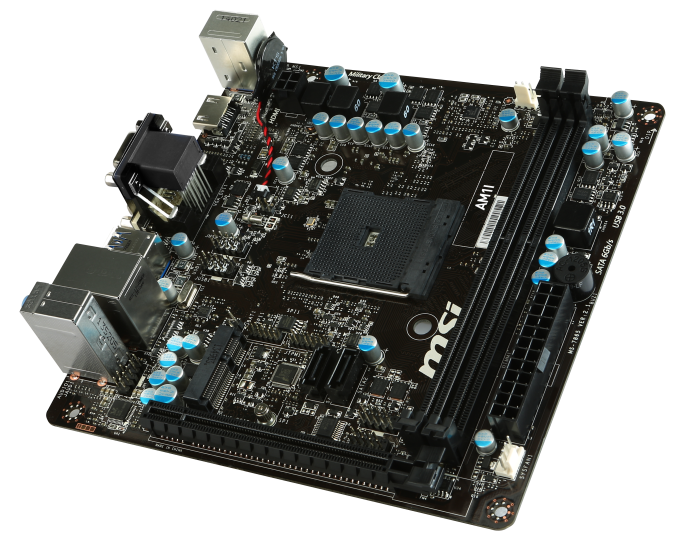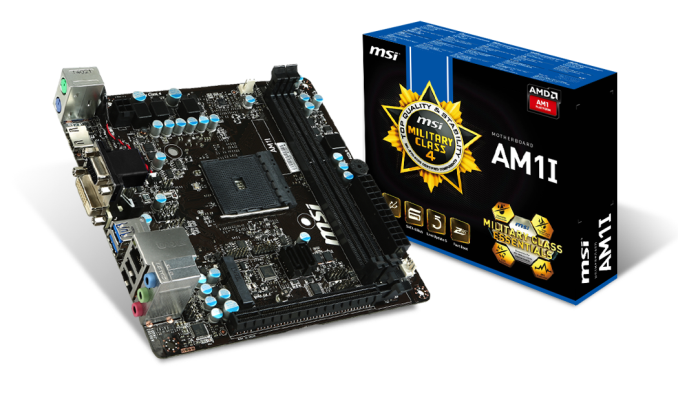The AM1 Kabini Motherboard Preview: Analyzing the Hardware
by Ian Cutress on April 19, 2014 2:00 PM ESTMSI AM1I
MSI has a single AM1 motherboard at Newegg at the time of writing, a mini-ITX model that takes a slightly different line. Being the cheapest AM1 mini-ITX motherboard (the Biostar AM1ML is more a half-way to micro-ATX), MSI has gone slightly creative and added a mini-PCIe slot. This opens up the platform for an integrated WiFi solution. It would be interesting to see what bundle price MSI could produce with a combined 802.11ac card.
MSI has learned from other mini-ITX projects and helpfully placed the 24-pin ATX connector outside the DRAM slots. The DRAM slots themselves use single-sided latches, to help with removing memory when a large PCIe device is installed. The PCIe slot, while an x4 designation from the chipset, seems to be fully populated with pins (which is a little odd).
Next to the mini-PCIe slot is a pair of SATA 6 Gbps ports, angled away from each other to allow easy removal of locking SATA cables. Perhaps confusingly the COM header and the front panel header are next to each other just inside the DRAM slots, and the front panel header is not labeled. Ideally this would be outside the DRAM slots on the right and labeled for ease of use.
The 4-pin CPU power connector is in a good position for cable management, and MSI have tried to save some cost by having the motherboard battery stuck to the rear panel.
The rear panel is similar to the previous motherboards, consisting of PS/2 ports, video outputs, two USB 3.0 ports, two USB 2.0 ports, an Ethernet port and ALC887 audio jacks.
| MSI AM1I | |
| Price | Link |
| Size | Mini-ITX |
| CPU Interface | FS1b |
| Chipset | Kabini |
| Memory Slots |
Two DDR3 DRAM slots, supporting 32GB Single Channel, 1333/1600 MHz |
| Video Outputs |
VGA (1920x1200) DVI-D (1920x1200) HDMI (4096x2160) |
| Onboard LAN | Realtek RTL8111G (10/100/1000) |
| Onboard Audio | Realtek ALC887 |
| Expansion Slots |
1 x PCIe 2.0 x16 (x4) 1 x mini-PCIe |
| Onboard SATA/RAID | 2 x SATA 6 Gbps |
| USB 3.0 | 2 x USB 3.0 (Chipset) [back panel] |
| Onboard |
2 x SATA 6 Gbps 2 x USB 2.0 Headers 2 x Fan Headers 1 x TPM Header 1 x COM Header Front Audio Header Front Panel Header |
| Power Connectors |
1 x 24-pin ATX 1 x 4-pin CPU |
| Fan Headers |
1 x CPU (3-pin) 1 x SYS (4-pin) |
| IO Panel |
1 x PS/2 Mouse Port 1 x PS/2 Keyboard Port VGA DVI-D HDMI 2 x USB 2.0 2 x USB 3.0 1 x Gigabit Ethernet Audio Jacks (ALC887) |
| Product Page | Link |
So far we have moved from $33 to $36 in our analysis and the changes made between the Biostar and MSI are actually quite drastic. The MSI platform (including MSI’s standard software one would assume), while slightly more expensive, offers a lot better value. The only downside is perhaps the name. Putting an ‘I’ next to a ‘1’, in the wrong font, makes the AM1I look odd.














64 Comments
View All Comments
Chrispy_ - Saturday, April 19, 2014 - link
The whole concept of an expensive AM1 motherboard is ridiculous, because as metioned in the article, once the CPU+platform cost reaches about $80 you could buy an FM2 solution which would be significantly more powerful and have many more features.Asus, in this case, completely misses the point.
silverblue - Saturday, April 19, 2014 - link
Yet it would be a dual core, with a much higher TDP. None of these Kabini boards are full ATX, either, so you're not forced into a large form factor.Admittedly, I would go FM2/FM2+ as I would want the performance, but I could make a much smaller and quieter PC with Kabini for obvious reasons.
johnny_boy - Monday, April 21, 2014 - link
Exactly (about the TDP). There's still reason to go AM1 over FM2(+) purely for thermal/wattage reasons. I was eyeing a super small ITX case with 60W pico PSU for HTPC use that could also serve for NAS purposes and be always on. I wouldn't run a 65-100W FM2 chip 24/7 or for HTPC use unless I wanted to do some light gaming.Ortanon - Monday, April 21, 2014 - link
This actually insinuates that a low-energy/low-heat desktop solution has a price premium the same way a high-performance desktop solution does. That kind of makes sense on the surface, but when you think about it things don't add up. A lower-TDP solution is necessarily less performant, but higher-TDP solutions aren't necessarily loud, and the differences in power draw are often negligible in terms of energy costs.All in all, a weaker system should be cheaper. Plain and simple. When I saw that it'd be at least $75 for an AM1 CPU/mobo, I just shook my head and moved along. Also they REALLY should've figured out a way to squeeze dual-channel into the spec.
My fantasy is for an AM1 board that has nothing but RAM slots and two full mini-PCIE slots. That's it. You slide a board full of cards into a tiny-ass case and boom. No stupid cables, no nothing. Hell, there's your under-$40 mobo right there. How difficult is that? I've been waiting for that for SO MANY years, and yet...
RoboJ1M - Tuesday, April 22, 2014 - link
You forgot no daft ATX+12 connector rubbish.You just want a DC jack on the back plate and some switched converters on board.
And an HDMI and a USB port on the back.
But yeah, that's what I'm looking for as well.
Case + Mobo + CPU + Ram + Laptop PSU = Internet PC.
Ortanon - Tuesday, April 22, 2014 - link
There are already SFF PSUs so that doesn't bother me as much. It just confuses me that after so many years of having mini-PCIe/mSATA, so few mini-ITX (!) motherboards have it, and far fewer than that have two (for your WiFi + SSD scenarios).Stand-alone cases could get a LOT smaller if that one change was made, not to mention the elimination of at least two cables from the build.
Really, I'd be looking to use full-speed mSATA storage on ANY size setup. The cards don't cost extra anymore.
solos - Friday, November 20, 2015 - link
Buy a notebook with broken screen (for next to nothing) , keep the bottom case and have your wish fullfilled ;)Flunk - Sunday, April 20, 2014 - link
If you don't produce things to hit different points of the market, how will you know they won't sell? It's worked for ASUS before.Samus - Monday, April 21, 2014 - link
Asus missed the point? ASRock is the one charging $60!ntgeralt - Saturday, April 19, 2014 - link
test